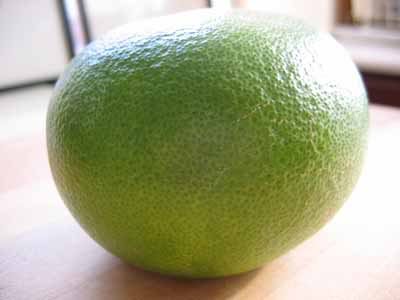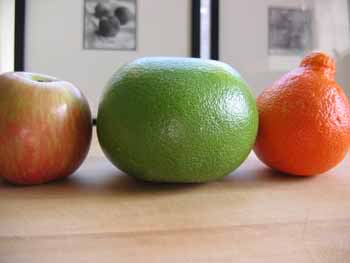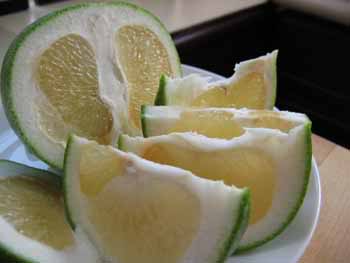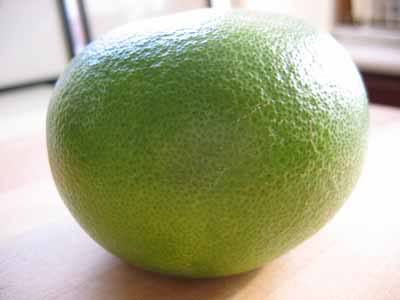
Yesterday S and I got a little stir-crazy, what with the blizzard and all. We piled on our snow gear and trekked over to Bedford Avenue, the heart of hipster Williamsburg. First we ate a leisurely late lunch/early dinner at Fornino (pesto pizza with caciotta piccante—a spicy, nutty cheese—and roast cherry tomatoes), and then made a quick stop at one of our fancy natural foods markets to stock up on fresh fruit. While I was picking granny smith apples (for my daily bowl of oatmeal, mmmm), S plucked a large green citrus fruit—it looked like a lime with a thyroid problem—off a pile and asked me what it was. I had no idea, but the sign said “Pumello 99¢.” I’d just read something, somewhere, about a Pomelo, although I had no idea what it was or where I read it; we were feeling adventurous and hey, it was only a buck. Into the basket it went.

(with an apple and a tangelo, for scale—it’s as big as a grapefruit, but squatter)
When I got home I checked my Larousse Gastronomique, which had this to say:
POMELO The largest of the citrus fruits, sometimes known as shaddock. The pomelo is pear-shaped, 20-30 cm (8-12 in) long, with a thick skin and a bitter, coarse flesh similar in flavour to the grapefruit. It can be eaten on its own or used in the same recipes as grapefruit.
Oh. I don’t really like grapefruit. In fact, it’s just about the only fruit I won’t eat.
Slightly dejected, I googled “pomelo,” and found this on GourmetSleuth.com:
This giant citrus (citrus grandus) fruit is native to Malaysia (where it still grows abundantly). It is also cultivated in California and Israel. Most of the varieties found today have been bred and grown. A large pomelo is the largest of all citrus. They can grow to be as large as a foot in diameter and up to 25 pounds. The rind is very thick but soft and easy to peel away. The resulting fruit is light yellow to coral-pink flesh and can vary from juicy to slightly dry and from seductively spicy-sweet to tangy and tart.
That sounded a little more promising. Into the fridge it went, and this morning we cut it open:

As you can see, there’s not all that much fruit in there, considering how frickin’ huge it is. Very thick peel, lots of pith, and a heavy membrane separating the sections. It smelled an awful lot like grapefruit. Still, I didn’t want to rush to judgment, so S and I sat down with the plate of pomelo sections between us, like the oranges that come with fortune cookies at Chinese restaurants. I nibbled cautiously, and—surprise—it tasted pretty good. Definitely reminiscent of grapefruit, but more delicate, with a touch more sweetness. The bitterness is an undertone here, rather than the star attraction. Lightly spicy. Those membranes are a pain in the butt, though—they’re really tough, and you definitely don’t want to get stuck chawin’ on a piece of it.
It took us under five minutes to finish the whole thing—like I said, not a lot of fruit in there. And just when I was about to say, “Hey that was pretty good. I’d buy that again,” the tingling started. My lips, and the tip of my tongue, like a mild case of pins and needles.
“S, do your lips tingle?”
S looked at me like he didn’t understand what I was asking. His lips did not tingle. I took a sip of water, and it intensified. It felt like my tongue was swelling. I ran to the mirror, expecting to see something out of The Mask, but all looked perfectly normal. Half an hour later, my mouth had resumed its usual sensations. Hmmph. Perhaps I’ll have to add pomelos to my list of weird recent allergies.
